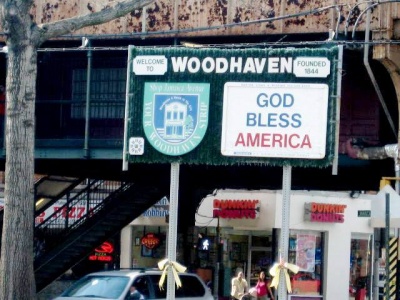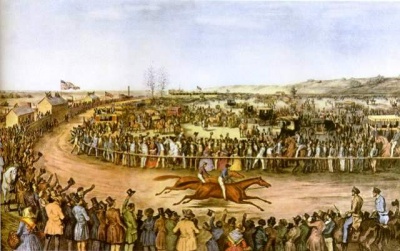Views
Woodhaven:Historial Overview
Woodhaven was birthed in the area adjoining the Brooklyn and Queens border near Cypress Hills. Its popularity grew out of its reputation to showcase horse racing and was the birthplace of three racetracks—Union Course, Centerville and Aqueduct. Before the Civil War, the pride of southern planters was to raise blooded horse and transport them north to race at New York racetracks which were established on the edges of the city. In 1821, Union Course was established just outside the settled portion of Brooklyn, an extension west of 79th street and east of 84th street and bordered by Jamaica Avenue on the north and Atlantic Avenue on the south. [1]
In spite of earlier efforts at establishing Woodhaven, it was the magnificent work of a Connecticut Yankee named John R. Pitkin, who was officially credited for founding this neighborhood in 1835. Pitkin happened to visit New Lots in East New York, Brooklyn, and was so impressed with what he saw that he developed and founded this zone that extended from Brooklyn to Jamaica south of the line of hills. Instead of abandoning the area to remain in anonymity and the dullness of a farm, Pitkin transformed it to be a place where thousands of people could enjoy the excitement and promise of an urban environment. [2]
Pitkin himself was an extraordinary person with an amazing history. As a young adult, he worked in the South as a merchant for a company in Winchester, Connecticut. Upon his return to New York in 1832, he entered the dry goods trade and amassed a huge fortune within several years. By then, Pitkin found his purpose in life and decided to spend his wealth and energy in a meaningful way. With determination, commitment and a supply of capital, he sought to establish his dream city east of the great metropolis of New York and named it East New York. With all the necessary capital and characteristics of a successful businessman, Pitkin continued to buy up the farms from Dutch burghers, including Van Siclen, Wyckoff and Snedeker. In his dream village, he established streets, avenues, houses, factories, churches and schools and even a port for shipping on Jamaica Bay. He ensured that the factories were established in the western part and separated from the residential areas and parks built in the eastern part of his dream city. When Pitkin finally bought out all the farms, he named the eastern part of the city Woodville.
In 1835, Pitkin finally bought out all the farms. He published maps showing streets and avenues as he did for East New York. Pitkin had the help of Martin B. Johnson. Martin B. Johnson was a surveyor who explored the land and made maps for Pitkin. Pitkin gave the eastern part of the city the name Woodville. It is thought by historians that Pitkin picked the name Woodville in order to honor the Wood family, landowners in the family.
However, there is no record of a Wood family of landowners in this district. The census of 1850 records shows that there were only four people named Wood in Jamaica. They were all tradesmen. If Pitkin’s intent were to honor the local old families, he would have had to honor the Elderts, the Lotts, the Wyckoffs or the Van Wicklens. Pitkin might have just been suggested the name because of what he discovered with his purchase. The name Woodville just means “woods-town”. [3]
It was a challenge to maintain East New York which declined to its death after residents abandoned the area and seek other opportunities. Pitkin did not give up his ambition of landownership. About 15 years later, business revived and Pitkin regained his confidence in Woodville. In 1850, with few houses in the settlement either on or near Woodhaven Boulevard, Pitkin was determined to colonize Woodville but was denied official registration of the name because another Woodville had existed in New York. However, on July 30, 1853, he successfully registered and changed the name to Woodhaven. That same year, Woodville got its first newspaper, the Woodville Advertiser& Literary Gazette, a four-page, twice-monthly publication, which consisted of ads for real estate. Unfortunately, the newspaper lasted only a year because the settlement was still too small to support a newspaper. [4]
In the early stages, Woodhaven had approximately 60 residents with most of them from German, Italian and Irish backgrounds. Building activities were taking place and a school was started in 1853. John Sharpe, an English edge tool manufacturer, who came from Sheffield, England, and operated his own manufactory in Manhattan, came to Woodhaven and set up a small factory to make chisels. In 1854, about two dozen people mysteriously arrived from Hyde Park in Vermont, to the Woodhaven. Two other settlers moved to Woodhaven and began a shoe manufacturing business. In 1858, Pitkin founded the “Pitkin Institute”, a trade school to teach boys shoe-craft, and which today is called 95th Avenue University Place. [5]
References
- ↑ Seyfried, Vincent F. (1985). The Story of Woodhaven and Ozone Park Woodhaven: Queens Community Series
- ↑ Seyfried, Vincent F. (1985). The Story of Woodhaven and Ozone Park Woodhaven: Queens Community Series
- ↑ Seyfried, Vincent F. (1985). The Story of Woodhaven and Ozone Park Woodhaven: Queens Community Series
- ↑ Seyfried, Vincent F. (1985). The Story of Woodhaven and Ozone Park Woodhaven: Queens Community Series
- ↑ Seyfried, Vincent F. (1985). The Story of Woodhaven and Ozone Park Woodhaven: Queens Community Series

